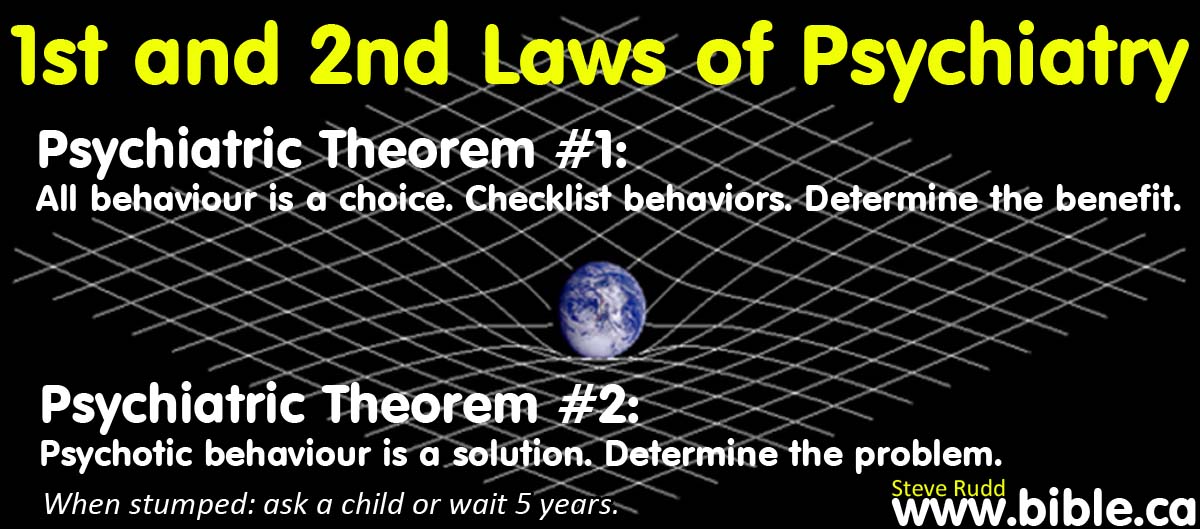The
case of "shampoo"
(Bi-polar disorder; Factitious disorder: Faking mental illness) F68.1
Casebook of Biblical Psychiatry © Version 7 (CBP-7)
|
Based upon |
Casebook of Biblical Psychiatry© brings the principles of Biblical Psychiatry to life based upon real-world cases and familiarizes Christians with different types of situations. This practical companion volume to Biblical Psychiatry© includes not only diagnosis, but also in-depth discussions by experienced Christians for Biblical approaches to treatment. This meticulously detailed volume of dynamic real-life case studies is simply a "must read" for all clinical Psychiatrists, mental health care professionals and Christians interested in expert opinion on today's treatment approaches. Psychiatric students, educators, and practitioners—as well as social workers, nurses, medical physicians, and interested laypersons—will find this unique volume of inestimable value in their day-to-day work.
|
|
|
|
||||
|
The case of "Shampoo" (Bi-polar disorder; Factitious disorder: Faking mental illness: F68.1) |
|
|||||
|
|
||||||
|
|
The case of "Shampoo" |
|
||||
|
|
Biopsychiatric labels DSM-5 |
Bi-polar disorder; Factitious disorder: Faking mental illness F68.1 |
||||
|
|
Checklist Behaviours DSM-7 |
Deception, lying, selfishness, narcissism, a documented history of fabricating sickness to gain a personal benefit. |
||||
|
|
Insights MMPI-7 |
|
||||
|
|
Quick Pick EDS-7.1 |
Sources of personal trauma: incest with her brother. |
||||
|
|
Self-disablement EDS-7.2 |
|||||
|
|
Chemical imbalance EDS-7.3 |
Yes. She ingested psychiatrist prescribed drugs for years. This indicates she likely has brain damage and Tardive Dyskinesia |
||||
|
|
Benefits EDS-7.4 |
Fun, entertainment, relief from boredom and monotony: EDS-7.4.2 Attention seeking, Pride, Praise, Honour, Fame: EDS-7.4.3 Sympathy: EDS-7.4.5 Control over others: EDS-7.4.6 Revenge: EDS-7.4.8 |
||||
|
|
Monetary EDS-7.5 |
- |
||||
|
|
Annoyance Scale EDS-7.6 |
Medium |
||||
|
|
Diagnostic Laws EDS-7.7 |
Law of Narcissistic Behaviour Choice (NBC) EDS-7.7.1.NBC Law of Derivative Personal Benefit (DPB) EDS-7.7.2.DPB Law of Narcissistic Selective Dysfunction (NSD) EDS-7.7.3.NSD Law of Domino Problem Transference (DPT) EDS-7.7.4.DPT Law of Annoyance Toleration Threshold (ATT) EDS-7.7.5.ATT Law of Psychopathic Modal Catalyst (PMC) EDS-7.7.8.PMC Law of Manipulative Rhetorical Malingering (MRM) EDS-7.7.9.MRM |
||||
|
|
Determine the Problem |
Self-centered, psychopathic, manipulative |
||||
|
|
Ask a Child |
I should teach her to hold her breath until she turns blue to get what she wants. It’s a whole lot easier and brings quicker results! EDS-7.7.12.PMO |
||||
|
|
5 years later EDS-7.7.LPT |
|||||
|
|
|
|||||
The case of "Shampoo"
Although Mary attended church most of her life on a regular basis, Mary was from a very dysfunctional family that included sexual relations with her brother and a father who was harsh, unfair and impossible to please.
At age 15 she did not want to go to school, so she told her parents that her tummy was real sore. Having read from the family encyclopedia where the appendix was located, she pointed to the correct place where her appendix was. She was booked for surgery and when they opened her up, they discovered there was nothing wrong. When she woke up from the surgery, she inserted little steel pins into the incision. She later said it was neat that she could do this and she could not feel it. 8 years later when she got pregnant, she told her husband she was worried the pins would kill the baby. The family did not believe her, but were surprised that x-rays confirmed the story. Surgery removed the pins. In an unfortunate twist, the child was stillborn.
When she was 17 years old, she began to experienced mood swings and was diagnosed with Bi-polar disorder. She was also put on anti-depressants. She was described as a teenager as one of the most selfish people the psychiatric nurse had ever seen. She had a strong need to get her way combined with the desire to feel needed.
Throughout her life, Mary had a pattern of using her mood swings as a way to gain power and control over others... or just to get her way. She would start getting hyper and excited and start yelling a bit, and the whole family would start catering to her so that her mental condition did not result in another stay in the mental hospital.
At retirement age, her husband was lost his job because of a car accident had was placed on permanent disability. Mary had been working full time throughout the 40 year marriage and the extra money was desperately needed. However, when she saw that her husband got to "stay at home and do what he wanted all day" and Mary had to work, she told her husband she wanted to quit. Her husband told her she couldn't quit right then because they needed the extra money.
Mary attempted to commit suicide by taking some pills and alcohol. She was discovered on the kitchen floor with a small dash in her wrist that drew a bit of blood. The drawer of knives were spilled all over the floor and the drawer was still open. There was a small amount of blood smeared over her body and the floor. The bleeding had stopped by the time she was discovered.
She was rushed to the mental ward again and remained there for observation for a week.
Her husband, who had a pattern of giving in to her wants, told her he thought it was best for her if she quit her job. She shampooed her hair in the hospital room, put nail polish and make-up on, changed her clothing and discharged herself about 4 hours later.
A few weeks after returning home, she told her son that she had faked the whole thing, only to force her husband into letting her quit. This, of course, created a firestorm inside the family. The son told his mother that he was concerned about leaving the kids with her to watch. This was something she really like to do and she really enjoyed being a "Granny". However her actions caused a permanent change in her relationship with her grandchildren.
Discussion:
Most people immediately focus on the sexual abuse she suffered at a young age at the hands of her brother. In fact, her brother may have been the victim of her sexual advances making her the offender. The details are sketchy as the story is told. However, even if she was the victim of incest from her brother, this does not justify her long pattern of manipulative, self-seeking behaviour. Perhaps she learned this behaviour from her dysfunctional family, but that does not make it acceptable so that others tolerate it and turn a blind eye.
While the inserting of pins into her body could be interpreted as self-hatred, this is not likely the reason she engaged in this self-destructive behaviour. She has already successfully learned how to fake appendicitis to skip school, much like the case of "Hooky" where Carl Jung, psychiatrist and founder of analytical psychology, learns for himself, what neurosis is. Now that she was in the hospital, she continued the charade by giving herself a future "get out of school" excuse by claiming she had pins in her stomach. Of course this time, unlike the appendicitis incident, doctors would indeed find something wrong with her.
Benefits from behaviour: This illustrates the Law of Narcissistic Behaviour Choice (NBC) EDS-7.7.1.NBC
- Fun, entertainment, relief from boredom and monotony: EDS-7.4.2. Clearly Mary was amusing herself when she acted out her little manipulative plots.
- Attention seeking, Pride, Praise, Honour, Fame: EDS-7.4.3. Mary was making herself the centre of attention for her own selfish purposes.
- Sympathy: EDS-7.4.5. With a psychiatric history, her family did not know when her behaviours were part of her "chemical imbalance" or part of her calculating manipulations. They tended to give sympathy, just to be on the safe side even though they suspected they were being manipulated.
- Control over others: EDS-7.4.6. Control was a huge factor that catalyzed many of her behaviours. So crass was her jealously that her husband would retire and she had to continue working, that she openly fabricated the need to spend a week in the mental ward of the hospital.
- Revenge: EDS-7.4.8. When Mary did not get what she wanted, she would make them feel guilty through her psychotic behaviour.
Diagnostic laws that are seen illustrated in the case of "Shampoo":
- In a textbook classic example, Mary was prepared to spend an entire week in a mental hospital until her husband agreed she could quit her job and join him in retirement. Many people would never believe a person would do such a thing, and in fact reject it as even being possible. But here is an actual case of someone wanting to live in an asylum. Mary had calculated the cost of being confined for one week in the asylum, as a bargain, if she never had to work again and could be free every day thereafter to do what she wanted. This illustrates the Law of Derivative Personal Benefit (DPB) EDS-7.7.2.DPB
- Mary found it easy to disable herself in things she did not want to do, but be fully functional in those things she liked doing. This illustrates the Law of Narcissistic Selective Dysfunction (NSD) EDS-7.7.3.NSD
- Mary would go to any extreme to get her selfish way even it is upset the entire family at great financial cost and time. This illustrates the Law of Domino Problem Transference (DPT) EDS-7.7.4.DPT
- Apparently this family had such a high threshold of annoyance, that Mary would make the demand herself to be taken to the mental hospital. They had a higher tolerance level than she was willing to breech. It was so much work for her to annoy them to trigger committal, that she just took the easy route and put herself in the mental hospital. This illustrates the Law of Annoyance Toleration Threshold (ATT) EDS-7.7.5.ATT
- Mary ignored requests to change her annoying behaviours, but instead she sought behaviour changes in how her family catered to her every whim, regardless of the harm she caused them. This illustrates the Law of Psychopathic Modal Catalyst (PMC) EDS-7.7.8.PMC
- Mary found herself unable to get what she wanted from others with normal modes of communication, so she manufacture odd behaviors and conditions to get what she wanted. Mary could not directly ask to be the dictator queen of the household, so she let her psychotic behaviour do the asking for her and it worked! This illustrates the Law of Manipulative Rhetorical Malingering (MRM) EDS-7.7.9.MRM
7. A child who observed Mary would say, “I should teach her to hold her breath until she turns blue to get what she wants. It’s a whole lot easier and brings quicker results given the urgency of the matter!” This illustrates the Law of Pediatric Multifarious Obfuscation (PMO) EDS-7.7.12.PMO
It is clear that Mary, like Carl Jung, learned that she could manipulate and control people with her fakery. However in the end, her pattern of self-seeking, narcissistic, psychopathic and psychotic behaviour caused her to lose the privilege "unsupervised" time with with her own grandchildren. Just like Carl Jung realized his faking had a very real negative consequence, so too Mary lost something she really wanted: her grandchildren.
Note: Although these are based upon real case stories, the names and details have been changed to hide the identities of the people. This practice follows the standards of medical case history publication.
By Steve Rudd: Contact the author for comments, input or corrections.
Send us your story about your experience with modern Psychiatry


